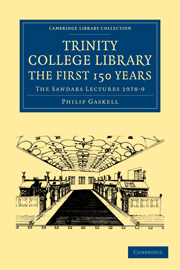Book contents
- Frontmatter
- Contents
- Lists of illustrations and plans
- Preface
- Terms and conventions
- Abbreviations
- 1546–1600
- 1601–1695
- 9 The New Library
- 10 Stanhope's Librarianship
- 11 Collections of manuscripts
- 12 The growth of the working collections, 1601–40
- 13 The arrangement of the books, 1601–40
- 14 Administration and reorganisation, 1641–74
- 15 The book stock, 1667–95
- 16 The last years of the New Library
- APPENDIXES
- Index
- Frontmatter
- Contents
- Lists of illustrations and plans
- Preface
- Terms and conventions
- Abbreviations
- 1546–1600
- 1601–1695
- 9 The New Library
- 10 Stanhope's Librarianship
- 11 Collections of manuscripts
- 12 The growth of the working collections, 1601–40
- 13 The arrangement of the books, 1601–40
- 14 Administration and reorganisation, 1641–74
- 15 The book stock, 1667–95
- 16 The last years of the New Library
- APPENDIXES
- Index
Summary
In his will dated 6 October 1556 John Christopherson, Master of Trinity, left the College all his books ‘to be placed in the Library of the said College, as sone as it shal be Buylded’. The Library that the College was then intending to build is shown on an old plan for laying out the principal court of Trinity. This plan is undated, and it was later altered by means of patches pasted over parts of it, but the original draft can be assigned with some confidence to the year 1555 (fig. 12). It shows a Library range running eastward from the King Edward Gate (in its original position), south of and parallel to the proposed new Chapel, and ending 20 feet short of the Great Gate. Adjacent to the King Edward Gate was a block containing a squared spiral staircase leading up to the library apartment, which was raised on an arcade and measured about 80ft × 28ft inside; with windows at seven-foot intervals and ordinary lectern cases it would have accommodated about 800 volumes.
On 14 December 1560 the preamble to a commission issued on behalf of Trinity by Queen Elizabeth for the provision of building materials and workmen spoke of ‘a Chappell and librarye lately begonne in the tyme of our late deere syster Quene Marye which remayneth at this presente vnfynished’. The building of the Chapel had started in 1556 and remained unfinished in 1560; as to beginning the library, there are a number of references in the accounts for 1554–5 to work on new buildings next to the King Edward Gate.
- Type
- Chapter
- Information
- Trinity College Library. The First 150 YearsThe Sandars Lectures 1978–9, pp. 61 - 74Publisher: Cambridge University PressPrint publication year: 2010First published in: 1980

